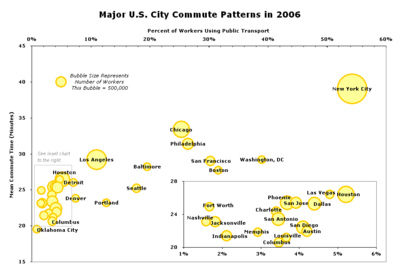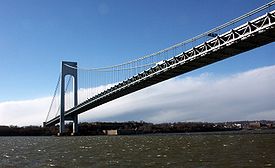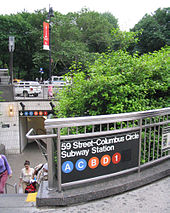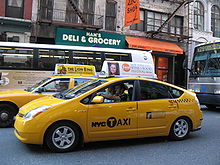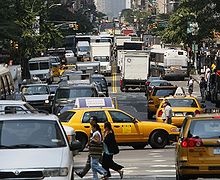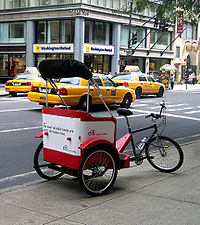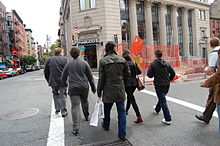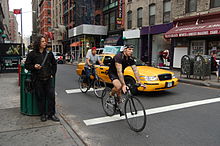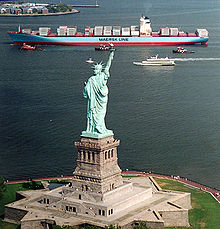- Transportation in New York City
-
Transportation in New York City Info Owner Metropolitan Transportation Authority, Port Authority of New York and New Jersey, local governments, states Locale New York City and the surrounding region in New York State, New Jersey, Connecticut and Pennsylvania Transit type Rapid transit, commuter rail, buses, private automobile, ferry, Taxicab, bicycle, pedestrian Daily ridership More than ten million commuters daily Operation Operator(s) Metropolitan Transportation Authority, Long Island Railroad, Port Authority Trans-Hudson, Metro-North Commuter Railroad Company, New Jersey Transit, and private operators The transportation system of New York City is a cooperation of complex systems of infrastructure. New York City, being the largest city in the United States, has a transportation system which includes the largest subway system in the world, measured by track mileage; the world's first mechanically ventilated vehicular tunnel, and an aerial tramway. Through prolonged use, and a distinct history of events, the infrastructure now faces increasing problems in functionality, dependability, and funding.
Contents
Background
History
Main article: History of New York City transportationThe history of New York City's transportation system began with the Dutch port of Nieuw Amsterdam. The port had maintained several roads; some were built atop former Lenape trails, others as "commuter" links to surrounding cities, and one was even paved by 1658 from orders of Petrus Stuyvesant, according to Burrow, et al.[1] The 19th century brought changes to the format of the system's transport- a street grid by 1811 (see the Commissioners' Plan of 1811), as well as an unprecedented link between New York and Brooklyn, then separate cities, via the Brooklyn Bridge, in 1883.
The Second Industrial Revolution fundamentally changed the city – the port infrastructure grew at such a rapid pace after the 1825 completion of the Erie Canal that New York became the most important connection between all of Europe and the interior of the United States. Elevated trains and subterranean transportation ('El trains' and 'subways') were introduced between 1867 and 1904. In 1904, the first subway line became operational.[2] Practical private automobiles brought an additional change for the city by around 1930, notably the 1927 Holland Tunnel. With automobiles gaining importance, the later rise of Robert Moses was essential to creating New York's modern road infrastructure. Moses was the architect of all 416 miles (669 km) of parkway, many other important roads, and seven great bridges.[3]
Mass transit use and car ownership
New York City is distinguished from other cities for its low personal automobile ownership and its significant use of public transportation. New York City has, by far, the highest rate of public transportation use of any American city, with 54.2% of workers commuting to work by this means in 2006.[4] About one in every three users of mass transit in the United States and two-thirds of the nation's rail riders live in New York City or its suburbs.[5] New York is the only city in the United States where over half of all households do not own a car (Manhattan's non-ownership is even higher - around 75%; nationally, the rate is 8%).[6]
New York City also has the longest mean travel time for commuters (39 minutes) among major U.S. cities.[4]
Environmental and social issues
New York City's uniquely high rate of public transit use makes it one of the most energy-efficient cities in the United States. Gasoline consumption in the city today is at the rate of the national average in the 1920s.[7] New York City's high rate of transit use saved 1.8 billion US gallons (6,800,000 m3) of oil in 2006 and $4.6 billion in gasoline costs. New York saves half of all the oil saved by transit nationwide.
The reduction in oil consumption meant 11.8 million metric tons of carbon dioxide pollution was kept out of the air.[8] The New York City metro area was ranked by the Brookings Institution as the U.S. metro area with the lowest per-capita transportation-related carbon footprint and as the fourth lowest overall per-capita carbon footprint in 2005 among the 100 largest metro areas of the United States, outranked only by Honolulu, Los Angeles and Portland.[9]
The city's transportation system, and the population density it makes possible, also have other effects. Scientists at Columbia University examined data from 13,102 adults in the city's five boroughs and identified correlations between New York's built environment and public health. New Yorkers residing in densely populated, pedestrian-friendly areas have significantly lower body mass index (BMI) levels compared to other New Yorkers. Three characteristics of the city environment—living in areas with mixed residential and commercial uses, living near bus and subway stops and living in population-dense areas—were found to be inversely associated with BMI levels.[10]
See also: Environmental issues in New York CityCommuting/modal split
Of all people who commute to work in New York City, 41% use the subway, 24% drive alone, 12% take the bus, 10% walk to work, 2% travel by commuter rail, 5% carpool, 1% use a taxi, 0.6% ride their bicycle to work, and 0.2% travel by ferry.[11] 54% of households in New York City do not own a car, and rely on public transportation.[12] While the so-called car culture dominates in most American cities, mass transit has a defining influence on New York life. The subway is a popular location for politicians to meet voters during elections and is also a major venue for musicians. Each week, more than 100 musicians and ensembles – ranging in genre from classical to Cajun, bluegrass, African, South American and jazz – give over 150 performances sanctioned by New York City Transit at 25 locations throughout the subway system.[13]
New York City compared Texas Transportation Institute Data New York Los Angeles Chicago Surveyed metro population 17.7 million 12.5 million 9.8 million Annual congestion delay per person 23 hrs 50 hrs 37 hrs Annual congestion cost per person $383 $855 $631 Rush hours per day 6 hrs 8 hrs 8 hrs Annual passenger miles of travel on public transit 18.5 billion 2.8 billion 2.2 billion Annual congestion cost saved by public transit $4.9 billion $2.2 billion $1.3 billion Excess fuel consumed per person due to congestion 11 gal
(42 L)33 gal
(125 L)23 gal
(87 L)Data from 2003 TTI Urban Mobility Report 3.7 million people were employed in New York City; Manhattan is the main employment center with 56% of all jobs.[14] Of those working in Manhattan, 30% commute from within Manhattan, while 17% come from Queens, 16% from Brooklyn, 8% from the Bronx, and 2.5% from Staten Island. Another 4.5% commute to Manhattan from Nassau County and 2% from Suffolk County on Long Island, while 4% commute from Westchester County. 5% commute from Bergen and Hudson counties in New Jersey.[14] Some commuters come from Fairfield County in Connecticut. Some New Yorkers reverse commute to the suburbs: 3% travel to Nassau County, 1.5% to Westchester County, 0.7% to Hudson County, 0.6% to Bergen County, 0.5% to Suffolk County, and smaller percentages to other places in the metropolitan area.[14]
Transit systems
Rail
 The New York City Subway is the lifeblood of the city. Shown is the Broadway – Lafayette Station on the IND.
The New York City Subway is the lifeblood of the city. Shown is the Broadway – Lafayette Station on the IND.
By far the dominant mode of transportation in New York City is rail. Only 6% of shopping trips in Manhattan's Central Business District involve the use of a car.[15] The city's public transportation network is the most extensive and among the oldest in North America. Responsibility for managing the various components of the system falls to several government agencies. The largest and most important is the Metropolitan Transportation Authority (MTA), a public benefit corporation in the state of New York, which runs all of the city's subways and buses and two of its three commuter rail networks. Ridership in the city increased 36% to 2.2 billion annual riders from 1995 to 2005, far outpacing population growth.[16][17] Average weekday subway ridership was 5.076 million in September 2006, while combined subway and bus ridership on an average weekday that month was 7.61 million.[18]
New York City Subway
Main article: New York City SubwayThe New York City Subway is the largest rapid transit system in the world when measured by track mileage (656 miles, or 1,056 km of mainline track), and the fourth-largest when measured by annual ridership (1.4 billion passenger trips in 2005).[5] It is the second-oldest subway system in the United States after the rapid transit system in Boston. In 2002, an average 4.8 million passengers used the subway each weekday. During one day in September 2005, 7.5 million daily riders set a record for ridership. Life in New York City is so dependent on the subway that the city is home to two of only four 24-hour subway systems in the world.[19] The city's 24 subway services run through all boroughs except Staten Island, which is served by the Staten Island Railway.
Subway riders pay with the MetroCard, which is also valid on all other rapid transit systems and buses in the city, as well as the Roosevelt Island tramway. The MetroCard has completely replaced tokens, which were used in the past, to pay fares. Fares are loaded electronically on the card.
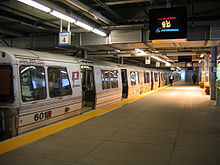 A PATH train at the World Trade Center station
A PATH train at the World Trade Center station
PATH
Main article: Port Authority Trans-HudsonThe Port Authority Trans-Hudson (PATH) is a rapid transit system that links Manhattan to Jersey City, Hoboken, Harrison and Newark, in New Jersey. A primary transit link between Manhattan and New Jersey, PATH carries 240,000 passengers each weekday on four lines.[20]
While some PATH stations are adjacent to subway stations in New York City and Newark as well as Hudson-Bergen Light Rail stations in Hudson County, there are no free transfers. The PATH system spans 13.8 miles (22.2 km) of route mileage, not including track overlap.[21] Like the New York City Subway, PATH operates 24 hours a day. Opened in 1908 as the Hudson and Manhattan Railroad, a privately owned corporation, PATH since 1962 has been operated by the Port Authority of New York and New Jersey.
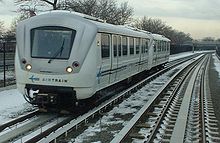 AirTrain at John F. Kennedy International Airport
AirTrain at John F. Kennedy International Airport
Airport services
Main articles: AirTrain JFK and AirTrain NewarkKennedy and Newark airports are served by intermodal rail systems. AirTrain JFK is an 8.1 mi (13 km) rapid transit system that connects Kennedy to New York's subway and commuter rail network in Queens. It also provides free transit between airport terminals. For trips beyond the airport, the train costs $5. Roughly 4 million people rode the AirTrain to and from Kennedy in 2006, an increase of about 15% over 2005.[22] AirTrain Newark is a 1.9-mile (3 km) monorail system connecting Newark's three terminals to commuter and intercity trains running on the Northeast Corridor rail line.
Commuter rail
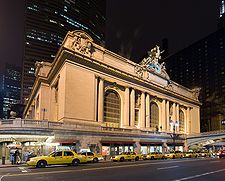 Grand Central Terminal is the second-busiest rail station in the country.
Grand Central Terminal is the second-busiest rail station in the country.
New York City's commuter rail system is the most extensive in the United States, with about 250 stations and 20 rail lines serving more than 150 million commuters annually in the tri-state region.[23] Commuter rail service from the suburbs is operated by two agencies. The MTA operates the Long Island Rail Road on Long Island and the Metro-North Railroad in the Hudson Valley and Connecticut. New Jersey Transit operates the rail network on the New Jersey side of the Hudson River. These rail systems converge at the two busiest train stations in the United States, Penn Station and Grand Central Terminal, both in Manhattan.
Intercity rail
Main article: Northeast CorridorWhile freight rail is not well-developed within the city limits (most freight activity occurs across the Hudson – in nearby areas of New Jersey), New York City has more frequent passenger rail service (intercity and commuter) than anywhere else in the nation. Intercity train service from New York City is provided by Amtrak. 54 trains run each day on the busiest route, New York to Philadelphia. For trips of less than 500 miles (800 km) to other Northeastern cities, Amtrak is often cheaper and faster than air travel. Amtrak accounts for 47% of all non-automobile intercity trips between New York and Washington, D.C. and about 14% of all intercity trips (including those by automobile) between those cities.[24] Amtrak's high-speed Acela trains run from New York to Boston and Washington, D.C. using tilting technology and fast electric locomotives. New York City's Penn Station is the busiest Amtrak station in the United States by annual boardings. In 2004 it saw 4.4 million passenger boardings, more than double the next busiest station, Union Station in Washington, D.C.[25] Overnight trains connect New York City with Chicago (where numerous connections are available to the west coast services), New Orleans, and Miami. There are two daily trains to Miami, while another train provides daytime service to Savannah. Chicago is connected with New York City by two trains: one which runs daily via Upstate New York and Cleveland, while another runs three times a week on a longer route via Cincinnati. Major destinations with frequent service include Albany, Baltimore, Boston, Harrisburg, Philadelphia, Providence, and Washington, D.C.. There are also daily trains to Toronto and Montreal in Canada.
 A Bx19 bus boards customers in Mott Haven, Bronx.
A Bx19 bus boards customers in Mott Haven, Bronx.
Buses
Main article: MTA Regional Bus OperationsSee also: New York City Transit buses, MTA Bus Company, Buses in New York City, and Select Bus ServiceNew York City's bus network is extensive, with over 5,900 buses carrying about 2.01 million passengers every day on more than 200 local routes and 30 express routes.[26] Buses owned by MTA account for 80% of the city's surface mass transit.[5] New York City has the largest clean-air diesel-hybrid and compressed natural gas bus fleet in the United States.[26]
Buses are labeled with a number and a prefix identifying the primary borough (B for Brooklyn, Bx for the Bronx, M for Manhattan, Q for Queens, and S for Staten Island). Express buses operated under MTA New York City Bus use the letter "x" rather than a borough label. Express buses routes operated under MTA Bus formerly controlled by the NYC Department of Transportation use a two-borough system with M at the end (i.e., BxM, QM, or BM).
The Port Authority Bus Terminal, near Times Square, is the busiest bus station in the United States and the main gateway for interstate buses into New York City. The terminal serves both commuter routes, mainly operated by New Jersey Transit, and national routes operated by companies such as Greyhound and Peter Pan.[27] Two discount services, BoltBus and Megabus announced discount intercity coach services to begin in late March 2008.[28]
Two private, for-profit bus companies, Hampton Jitney and Hampton Luxury Liner, operate 7-day-a-week, year-round service from points on the east side of Manhattan to the villages and hamlets of Long Island's east end, best known as the Hamptons, Montauk, and the North Fork.
The larger of the two companies, Hampton Jitney, also runs limited service to and from Lower Manhattan and Brooklyn. These bus companies owe their prosperity in part to the very poor services provided to this region by the Long Island Railroad.
Intercity bus stations
Intercity bus operators use the following stations:
Borough Major terminals Manhattan: - Port Authority Bus Terminal (most intercity bus operators)
- George Washington Bridge Bus Terminal (New Jersey Transit and Coach USA Rockland Coaches)
- New York Penn Station (Megabus, BoltBus and Vamoose Bus)
Queens: - LaGuardia Airport
- John F. Kennedy International Airport - Terminal 4
Ferries
The busiest ferry in the United States is the Staten Island Ferry, which annually carries over 19 million passengers on the 5.2 mile (8.4 km) run between St. George Ferry Terminal and South Ferry. Service is provided 24 hours a day, 365 days a year, and takes approximately 25 minutes each way. Each day eight boats transport almost 65,000 passengers during 104 boat trips. Over 33,000 trips are made annually.[29] The Ferry has remained free of charge since 1997. Vehicles have not been allowed on the Ferry since the September 11, 2001 terrorist attacks, though bicycles are permitted on the lower level at no cost. The ferry ride is a favorite of tourists as it provides excellent views of the Lower Manhattan skyline and the Statue of Liberty.
Since the 1980s ferry service on the Hudson River and East River has been restored and significantly expanded providing regular service to points in Manhattan, mostly below 42nd Street. Pier 11 at Wall Street, East 34th Street Ferry Landing, West Midtown Ferry Terminal and Battery Park City Ferry Terminal are major embarkation points. The terminals are run in public-private partnership with privately owned carriers. Under the NY Waterway logo routes are run to Hoboken Terminal, Weehawken Port Imperial, Edgewater Landing, and Paulus Hook Ferry Terminal as well as other ferry slips along the west bank of the Hudson in New Jersey. It's East River shuttles between Wall Street and East 34th Street calling at four slips in Brooklyn and Queens. It also operates routes to the Raritan Bayshore, as does SeaStreak. New York Water Taxi makes an East River crossing to Red Hook. Liberty Water Taxi travels between BPC Ferry Terminal and Liberty State Park in Jersey City stopping at Paulus Hook. The companies also run seasonal excursions, notably to the Yankee Stadium and Gateway National Recreation Area beaches.
Additionally, there is year-round ferry service to Ellis Island and Liberty Island[30] and seasonal service to Governor's Island[31][32] Circle Line Downtown[33] and Circle Line Sightseeing[34] operate tourist routes into the Upper New York Bay or circumnavigate Manhattan.
Roads and freeways
Despite New York's reliance on public transit, roads are a defining feature of the city. Manhattan's street grid plan greatly influenced the city's physical development. Several of the city's streets and avenues, like Broadway, Wall Street and Madison Avenue are also used as shorthand or metonym in American vernacular for national industries located there: theater, finance, and advertising, respectively.
In Manhattan there are twelve numbered avenues that run parallel to the Hudson River, and 220 numbered streets that run perpendicular to the river.
An advanced convergence indexing road traffic monitoring system was installed in New York City for testing purposes in May 2008.
See also: Geography and environment of New York City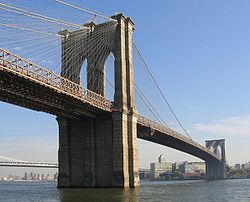 The Brooklyn Bridge, one of New York's most recognizable structures.
The Brooklyn Bridge, one of New York's most recognizable structures.
Bridges and tunnels
Main article: Bridges and tunnels in New York CityWith its Gothic-revival double-arched stone towers and diagonal suspension wires, the Brooklyn Bridge is one of the city's most recognized architectural structures, depicted by artists such as Hart Crane and Georgia O'Keeffe. The Brooklyn Bridge's main span is 1,596 feet (486 m) and 6 inches (150 mm), and was the longest in the world when it was completed. The Williamsburg Bridge and Manhattan Bridge are the two others in the trio of architecturally notable East River crossings. The Queensboro Bridge, which links Manhattan and Queens, is an important piece of cantilever bridge design. The borough of Staten Island is connected to Brooklyn through the Verrazano-Narrows Bridge. The towers of the Verrazano, which rise 650 feet (200 m) above the water, are 4,260 feet (1,300 m) apart; these towers are so far away from each other, due to the length of the main span, that there is a 13⁄8 inches (34 mm) displacement between the theoretical position of the side at the top of the tower, and the actual position, due to the Earth's curvature. The George Washington Bridge, spanning the Hudson River between New York City and Fort Lee, New Jersey, is the world's busiest bridge in terms of vehicular traffic.[35][36]
New York has historically been a pioneer in tunnel construction. Most carry rail lines. The Lincoln Tunnel, which carries 120,000 vehicles per day under the Hudson River between New Jersey and Manhattan, is the world's busiest vehicular tunnel. The Holland Tunnel, also under the Hudson River, was the first mechanically ventilated vehicular tunnel in the world and is considered a National Civil Engineering Landmark by the American Society of Civil Engineers. Two other notable tunnels connect Manhattan to other places; one is the Queens Midtown Tunnel, and the other the Brooklyn-Battery Tunnel. At 9,117 feet (2,779 m), the Brooklyn-Battery Tunnel is the longest underwater tunnel in North America.
Expressways
A less favored alternative to commuting by rail and boat is the New York region's expressway network, designed by Robert Moses. The city's extensive network of expressways includes four primary Interstate Highways: I-78, I-80, I-87 and I-95. I-278 and I-287 each serve as a partial beltway around the city. The Long Island Expressway begins at the Queens Midtown Tunnel and runs through the heart of Queens east into the Long Island suburbs.
New York's limited-access parkways, another Moses Project, are frequently congested as well, despite being designed from the outset to only carry cars, as opposed to commercial trucks or buses. The FDR Drive and Harlem River Drive are two such routes through Manhattan. The Henry Hudson Parkway, the Bronx River Parkway and the Hutchinson River Parkway link the Bronx to nearby Westchester County and its parkways, and the Grand Central Parkway and Belt Parkway provide similar functions for Long Island's parkway system.
Private automobiles
New York's traffic lights are controlled from a Department of Transportation center in Long Island City, with frequent adjustments to alleviate the city's chronic congestion.[37]
Around 48% of New Yorkers own cars, yet fewer than 30% use them to commute to work, most finding public transportation cheaper and more convenient for that purpose, due in large part to traffic congestion which also slows buses. To ease traffic, the Mayor, Michael Bloomberg, in 2007 proposed congestion pricing for motor vehicles entering Manhattan's business district from 6:00 a.m. to 6:00 p.m. However, this proposal was defeated when Sheldon Silver Speaker of the New York State Assembly announced that the bill would not come up for a vote in his chamber.
Main article: New York congestion pricingTaxis
Main article: New York City Taxi and Limousine CommissionThere are 13,237 taxis operating in New York City, not including over 40,000 other for-hire vehicles.[38] Their distinctive yellow paint has made them New York icons.
Taxicabs are operated by private companies and licensed by the New York City Taxi and Limousine Commission. "Medallion taxis", the familiar yellow cabs, are the only vehicles in the city permitted to pick up passengers in response to a street hail. A cab’s availability is indicated by the lights on the top of the car. When just the center light showing the medallion number is lit, the cab is empty and available. When no lights are lit, the cab is occupied by passengers.
Fares begin at US$2.50 and increase based on the distance traveled and time spent in slow traffic. The passenger also must pay for tolls incurred during the ride.[39] The average cab fare in 2000 was US$6.00; over US$1 billion in fares were paid that year in total.[citation needed]
241 million passengers rode in New York taxis in 1999. According to the 2000 U.S. Census, of the 42,000 cabbies in New York, 82% are foreign born: 23% from the Caribbean (the Dominican Republic and Haiti), and 20% from South Asia (India, Pakistan, and Bangladesh).[citation needed]
In 2005, New York introduced incentives to replace its current yellow cabs with electric hybrid vehicles [40] then in May 2007, New York City Mayor, Michael Bloomberg, proposed a five-year plan to switch New York City's taxicabs to more fuel-efficient hybrid vehicles as part of an agenda for New York City to reduce greenhouse gas emissions as well as surging fuel costs.[41] In 2010, Nissan won a contract to provide the New York with a design based on their NV200 minivan model.
Pedicabs, pedestrians, and bicycles
Cycling in New York City is a rapidly growing mode of transport. In 2009, an estimated 200,000 city residents bicycle on a typical day[42], and make 655,000 trips each day, greater than the number of the ten most popular bus routes in the city.[43] The City Department of Transportation estimates there are an additional two in-line skaters for every cyclist in New York. The city has 420 miles (680 km) of bike lanes (as of 2005) including the Manhattan Waterfront Greenway and has in recent years expanded separated bike lanes on major thoroughfares and on bridges across the East River. As part of PlaNYC 2030, bike lanes will be added at a rate of about 100 miles per year until 2010, and 1,800 miles (2,900 km) should be completed by 2030.
The city annually hosts the largest recreational cycling event in the United States, the Five Boro Bike Tour, in which 30,000 cyclists ride 42 miles (68 km) through the city's boroughs.
More than 500 people annually work as bicycle rickshaw aka pedicab drivers, who in 2005 handled one million passengers.[44] The City Council voted twice, including an override of Mayor Bloomberg's veto due to the market cap, in 2007 to license pedicab owners and drivers and allow only 325 pedicab licenses.[45] Neither the limit on pedicabs nor the law itself went into effect due to a successful New York City Pedicab Owners' Association lawsuit over permit issuance.[46] Ultimately, 943 pedicab business owners permits were issued in November 2009 after a second law was passed to address shortcomings of the 2007 law.[47] Today, pedicabs meet market demand in midtown for both ecological transport as well as quick trips within the central business district during afternoon rush hours when vehicular traffic moves cross town at an average speed of 4.5 miles per hour.
Walk and bicycle modes of travel account for 21% of all modes for trips in the city; nationally the rate for metro regions is about 8%.[48] In 2000 New York had the largest number of walking commuters among large American cities in both total number and as a proportion of all commuters: 517,290, or 5.6%.[49] By way of comparison, the next city with the largest proportion of walking commuters, Boston, had 119,294 commuter pedestrians, amounting to 4.1% of that city's commuters.[49]
Semi-formal
Passengers at the ticket window of a Chinatown bus company.
New York has many forms of semi-formal public transportation, including "dollar vans" and "Chinese vans." Dollar vans serve major corridors in Brooklyn, Queens and the Bronx that lack adequate subway service. In 2006, the New York City Council began debate on greater industry regulation, including requiring all dollar vans to be painted in a specific color to make them easier to recognize, similar to the public light buses in Hong Kong.[50] The vans pick up and drop off anywhere along a route, and payment is made at the end of a trip.
Similar to dollar vans, Chinese vans serve predominantly Chinese communities in Chinatown, Manhattan, Chinatown, Flushing, Sunset Park, Brooklyn, Elmhurst, Queens and Homecrest, Brooklyn.
Highly competitive Chinatown bus lines operate routes from New York City's Chinatowns to other Chinatowns in the Northeast, with frequent service to major cities like Boston and Philadelphia. These companies use full-size coaches and offer fares much lower than traditional carriers like Greyhound and Coach USA, who in turn have gone after the Chinatown carriers by offering online fares as low as $1 on BoltBus, NeOn, and Megabus services.
Other services in the city include Rightrides, a free late night ride home service to shuttle women and LGBTQ individuals home on Friday and Saturday.
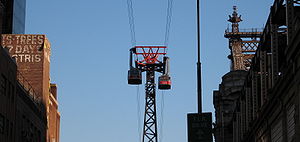 Roosevelt Island Tramway over the East River.
Roosevelt Island Tramway over the East River.
Aerial tramway
Main article: Roosevelt Island TramwayBuilt in 1976 to shuttle island residents to Midtown, the Roosevelt Island Tramway was originally intended to be a temporary commuter link for use until a subway station was established for the island. However, when the subway finally connected to Roosevelt Island in 1989, the tram was too popular to discontinue use.
The Tramway is operated by the Roosevelt Island Operating Corp (RIOC). Each cable car has a capacity of 125 passengers. Travel time from Roosevelt Island to Manhattan is just under five minutes and the fare is the same as a subway ride.
In 2006, service was suspended on the tramway for six months after a service malfunction that required all passengers to be evacuated.
Port Infrastructure
Airports
Main article: Aviation in New York City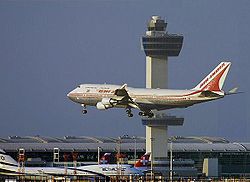 An Air India 747 arrives at JFK, with El Al Israel and Swiss International jets at Terminal 4. JFK is the largest entry point for international arrivals to the United States.
An Air India 747 arrives at JFK, with El Al Israel and Swiss International jets at Terminal 4. JFK is the largest entry point for international arrivals to the United States.
New York City is the top international air passenger gateway to the United States.[51] 100 million travelers used the city's airports in 2005; New York is the busiest air gateway in the nation.[52]
The city is served by three major airports: John F. Kennedy International (also known as JFK), Newark Liberty International, and LaGuardia. Teterboro serves as a primary general aviation airport. JFK and Newark both connect to regional rail systems by a light rail service.[53]
JFK and Newark serve long-haul domestic and international flights. The two airports' outbound international travel accounted for about a quarter of all U.S. travelers who went overseas in 2004.[54] LaGuardia caters to short-haul and domestic destinations.
JFK is the major entry point for international arrivals in the United States and is the largest international air freight gateway in the nation by value of shipments.[55] About 100 airlines from more than 50 countries operate direct flights to JFK. The JFK-London Heathrow route is the leading U.S. international airport pair.[56] The airport is located along Jamaica Bay near Howard Beach, Queens, about 12 miles (19 km) east of downtown Manhattan.
Newark was the first major airport serving New York City and is the fifth busiest international air gateway to the United States.[51] Amelia Earhart dedicated the Newark Airport Administration Building in 1935, which was North America's first commercial airline terminal. In 2003, Newark became the terminus of the world's longest non-stop scheduled airline route, Continental's service to Hong Kong. In 2004, Singapore Airlines broke Continental's record by starting direct 18-hour flights from Newark to Singapore. The airport is located in Newark, New Jersey, about 12 miles (19 km) west of downtown Manhattan.
LaGuardia, the smallest of New York's primary airports, handles domestic flights. It is named for Fiorello H. LaGuardia, the city's great Depression-era mayor known as a reformist and strong supporter of the New Deal. A perimeter rule prohibits incoming and outgoing flights that exceed 1,500 miles (2,400 km) except on Saturdays, when the ban is lifted, and to Denver, which has a grandfathered exemption. As a result, most transcontinental and international flights use JFK and Newark.[57] The airport is located in northern Queens about 6 miles (9.7 km) from downtown Manhattan.
Manhattan has three public heliports, used mostly by business travelers. A regularly scheduled helicopter service operates flights to JFK Airport from the Downtown Manhattan Heliport, located at the eastern end of Wall Street. There are also the East 34th Street Heliport and the West 30th Street Heliport
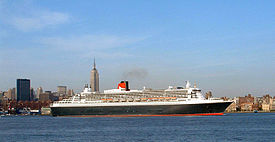 The Queen Mary 2, the world's second largest passenger ship and the world's largest Ocean liner, steams out of New York on a transatlantic voyage.
The Queen Mary 2, the world's second largest passenger ship and the world's largest Ocean liner, steams out of New York on a transatlantic voyage.
Seaports
The Port of New York and New Jersey, with its natural advantages of deep water channels and protection from the Atlantic Ocean, has historically been one of the most important ports in the United States, and is now the third busiest in the United States behind Los Angeles and Long Beach, California in the amount of volume. Each year, more than 25 million tons of oceanborne general cargo moves through the port, including 4.5 million TEUs (twenty-foot equivalent units) of containerized cargo. In 2005 more than 5,300 ships delivered goods to the port that went to 35% of the U.S. population.[58] The port is experiencing rapid growth. Shipments increased nearly 12% in 2005. There are three cargo terminals on the New York City side of the harbor, including the Howland Hook Marine Terminal, Red Hook Container Terminal, Brooklyn Marine Terminal in Red Hook, Brooklyn. Several additional cargo terminals and a passenger terminal are on the New Jersey side.
The New York Harbor is also a major hub for passenger ships. More than half a million people depart annually from Manhattan's New York Passenger Ship Terminal on the Hudson River, accounting for five percent of the worldwide cruise industry and employing 21,000 residents in the city. The Queen Mary 2, the world's second largest passenger ship and one of the few traditional ocean liners still in service, was designed specifically to fit under the Verrazano Bridge, itself the longest suspension bridge in the United States. The Brooklyn Cruise Terminal is her regular port of call for transatlantic runs from Southampton, England. Cape Liberty Cruise Port in Bayonne is the third passenger terminal service the city.
Originally focused on Brooklyn's waterfront, especially at the Brooklyn Army Terminal in Sunset Park, most container ship cargo operations have shifted to the Port Newark-Elizabeth Marine Terminal on Newark Bay. The terminal, operated by the Port Authority of New York and New Jersey, is the largest port complex on the East Coast. $114.54 billion of cargo passed through the Port of New York and New Jersey in 2004. The top five trading partners at the port are China, Italy, Germany, Brazil and India.
Water quality in the New York Harbor improved dramatically in the late 20th century. New Yorkers regularly kayak and sail in the harbor, which has become a major recreational site for the city.
Future and proposed projects
Several proposals for expanding the New York City transit system are in various stages of discussion, planning, or initial funding. Some of them would compete with others for available funding.
- In January 2007, the Port Authority approved plans for the $78.5 million purchase of a lease of Stewart Airport in Newburgh, New York as a 4th major airport for the area.[59]
- PATH World Trade Center station, whose construction began in late 2005, will replace the temporary PATH terminal that replaced the one destroyed in the September 11 attacks. This new central terminal, designed by Santiago Calatrava, will allow easy transfer between the PATH system, several subway lines and proposed new projects. It is expected to serve 250,000 travelers daily.
- Fulton Street Transit Center, a $750 million project in Lower Manhattan that will improve access to and connections between 12 subway lines, PATH service and the World Trade Center site. Construction began in 2005, and completion is scheduled for 2014.[60]
- Moynihan Station would expand Penn Station into the James Farley Post Office building across the street. The first phase has been fully funded.
- Second Avenue Subway, a new north-south line, first proposed in 1929, would run from 125th Street in Harlem to Hanover Square in lower Manhattan. The first phase, from 63rd Street to 96th Street, is under construction, and is scheduled to be opened to passenger service in the late 2010s.
- IRT Flushing Line Extension would extend the number 7 subway service west along 42nd Street from its current terminus at Times Square, then south along 11th Avenue to the Jacob K. Javits Convention Center. Tunnel construction began in 2008, and operational service is scheduled for 2013 at the earliest.
- East Side Access project will route some Long Island Rail Road Trains to Grand Central Terminal instead of Penn Station. Since many, if not most, LIRR commuters work on the east side of Manhattan, many in walking distance of Grand Central, this project will save travel time and reduce congestion at Penn Station and on subway lines connecting it with the east side. It will also greatly expand the hourly capacity of the LIRR system. Completion is scheduled for 2015.
- The Lower Manhattan-Jamaica/JFK Transportation Project would extend an existing Long Island Rail Road line from Jamaica Station, with a new 3-mile (4.8 km) tunnel under the East River from downtown Brooklyn to Manhattan. AirTrain JFK-compatible cars would run along the new route, connecting John F. Kennedy International Airport and Jamaica with Lower Manhattan. This project is still just a proposal, although it has the support of Mayor Michael Bloomberg.[citation needed]
- Access to the Region's Core would add a second pair of railroad tracks under the Hudson River, connecting an expanded Penn Station to NJ Transit lines. This project was initially approved, but was canceled in October 2010 by New Jersey Governor Chris Christie, citing the possibility of cost overruns and the state's lack of funds.
- Although New York City does not have light rail, a few proposals exist:
- There are plans to convert 42nd Street into a light rail transit mall which would be closed to all vehicles except emergency vehicles [3]. The idea was previously planned in the early 1990s, and was approved by the City Council in 1994, but stalled due to lack of funds.
- Staten Island light rail proposals have found political support from Senator Charles Schumer and local political and business leaders.
- JFK Airport is undergoing a US$10.3 billion redevelopment, one of the largest airport reconstruction projects in the world. In recent years, Terminal One, Terminal Four. Terminal Eight, and Terminal Five have been reconstructed.[citation needed]
- Santiago Calatrava has also proposed an aerial gondola system linking Manhattan, Governors Island and Brooklyn as part of the city's plans to develop the island.
- As part of a long-term plan to manage New York City's environmental sustainability, Mayor Michael Bloomberg released several proposals to increase mass transit usage and improve overall transportation infrastructure.[61] Apart from support of the above capital projects, these proposals include the implementation of bus rapid transit, the reopening of closed LIRR and Metro-North stations, new ferry routes, better access for cyclists, pedestrians and intermodal transfers, and a congestion pricing zone for Manhattan south of 86th Street.
See also
- Mass transit in New York City
- Cycling in New York City
- New York City Department of Transportation
- List of U.S. cities with most pedestrian commuters
Further reading
- Ascher, Kate, The Works: Anatomy of a City, 2005
- Cheape, Charles W., Moving the masses: urban public transit in New York, Boston, and Philadelphia, 1880-1912, Harvard University Press, 1980. ISBN 0-674-58827-4
- Mathew, Biju, Taxi!: Cabs and Capitalism in New York City, 2005
- Solis, Julia, New York Underground, 2004
- Tanenbaum, Susie J., Underground Harmonies: Music and Politics in the Subways of New York , 1995
References
- ^ Burrows, et al. (1999). Gotham. Oxford Press. ISBN 0195116348.
- ^ James Blaine Walker, Fifty Years of Rapid Transit, 1864-1917, published 1918, pp. 162-191
- ^ Caro, Robert A. (1975). The Power Broker; Robert Moses and the Fall of New York. Vintage Books. ISBN 0394720245.
- ^ a b U.S. Census Bureau, American Community Survey 2006, Table S0802
- ^ a b c Metropolitan Transportation Authority. "The MTA Network". http://www.mta.info/mta/network.htm. Retrieved 2006-05-17.
- ^ Bureau of Transportation Statistics, U.S. Department of Transportation (2001). "Highlights of the 2001 National Household Travel Survey". http://www.bts.gov/publications/highlights_of_the_2001_national_household_travel_survey/html/executive_summary.html. Retrieved 2006-05-21.
- ^ Jervey, Ben (2006). The Big Green Apple. Globe Pequot Press. ISBN 0762738359. See Metro New York article:[1]
- ^ "A Better Way to Go: Meeting America's 21st Century Transportation Challenges with Modern Public Transit" (PDF). U.S. Public Interest Research Group. March 2008. http://www.uspirg.org/uploads/2q/fV/2qfVu2ZrflTk-TnRQEDdDw/A-Better-Way-to-Go-vUSPIRG.pdf. Retrieved 2008-04-23.
- ^ Sarzynski, Andrea, Shrinking the Carbon Footprint of Metropolitan America (Brookings Institute: 2008)[2]
- ^ Andrew Rundle, Dr. P.H. (March 2007). "Living Near Shops, Subways connected to Lower BMI in New York City". American Journal of Health Promotion. http://www.healthpromotionjournal.com/publications/journal.htm. See also this news release and this article.
- ^ "Table B08406. Sex of Workers by Means of Transportation for Workplace Geography - Universe: Workers 16 Years and Over". 2004 American Community Survey. United States Census Bureau. http://factfinder.census.gov/servlet/DTTable?_bm=y&-context=dt&-ds_name=ACS_2009_1YR_G00_&-CONTEXT=dt&-mt_name=ACS_2009_1YR_G2000_B08301&-tree_id=309&-redoLog=false&-geo_id=16000US3651000&-geo_id=16000US4805000&-search_results=16000US4805000&-format=&-SubjectID=18600011.
- ^ "Table B08201. Household Size by Vehicles Available - Universe: Households". 2009 American Community Survey. United States Census Bureau. http://factfinder.census.gov/servlet/DTGeoSearchByListServlet?ds_name=ACS_2004_EST_G00_&_lang=en&_ts=170243153266.
- ^ Metropolitan Transportation Authority (2007). "Music Under New York". http://www.mta.info/mta/aft/muny/. Retrieved 2007-02-18.
- ^ a b c "County-To-County Worker Flow Files". Census 2000. United States Census Bureau. http://www.census.gov/population/www/cen2000/commuting.html.
- ^ Transportation Alternatives (February 2006). "Necessity or Choice? Why People Drive in Manhattan". http://www.transalt.org/campaigns/reclaiming/schaller_Feb2006.ppdf. Retrieved 2007-02-18.[dead link]
- ^ Lueck, Thomas J. (August 24, 2006). "M.T.A. Ridership Grows Faster Than Population". The New York Times. http://www.nytimes.com/2006/08/24/nyregion/24mbrfs-005.html. Retrieved 2006-08-26.
- ^ "MTA Ridership Takes Express with 31% Surge". New York Post. August 24, 2006. http://www.nypost.com/news/regionalnews/mta_ridership_takes_express_with_31__surge_regionalnews_jeremy_olshan.htm. Retrieved 2006-08-26.[dead link]
- ^ Neuman, William (November 29, 2006). "Manhattan: Record Use for Subways". The New York Times. http://www.nytimes.com/2006/11/29/nyregion/29mbrfs-RECORDUSEFOR_BRF.html. Retrieved 2007-02-18.
- ^ The New York City Subway and the PATH both operate 24 hours a day.
- ^ American Public Transportation Association. "APTA Ridership Report: Third Quarter 2006" (PDF). Archived from the original on 2007-06-15. http://web.archive.org/web/20070615121802/http://www.apta.com/research/stats/ridership/riderep/documents/06q3rep.pdf. Retrieved 2007-02-18.
- ^ Hoboken Terminal (May 1995). "PATH at a Glance". http://www.hobokenterminal.com/path/path_glance.html. Retrieved 2007-02-18.
- ^ "Manhattan: Train-to-Plane Use Sets Record". The New York Times. January 17, 2007. http://www.nytimes.com/2007/01/17/nyregion/18mbrfs-record.html?_r=1&oref=login. Retrieved 2007-02-18.
- ^ Metropolitan Transportation Authority. "About the MTA Long Island Railroad". http://www.mta.nyc.ny.us/lirr/pubs/aboutlirr.htm. Retrieved 2007-02-18.[dead link]
- ^ Congressional Budget Office (September 2003). "The Past and Future of U.S. Passenger Rail Service" (PDF). http://www.cbo.gov/ftpdocs/45xx/doc4571/09-26-PassengerRail.pdf. Retrieved 2007-02-18.
- ^ "TABLE 1-8 Top 50 Amtrak Stations by Number of Boardings: Fiscal Year 2004"]. Transportation Statistics Annual Report 2005. Bureau of Transportation Statistics, U.S. Department of Transportation. November 2005. http://www.bts.gov/publications/transportation_statistics_annual_report/2005/html/appendix_b/html/table_01_08.html. Retrieved 2006-06-11.
- ^ a b Metropolitan Transportation Authority (May 1, 2006). "2005 Annual Report" (PDF). http://mta.info/mta/investor/pdf/2005_annual_report.pdf. Retrieved 2007-02-18.
- ^ Port Authority of New York and New Jersey. "History of the Port Authority Bus Terminal". Archived from the original on 2007-01-27. http://web.archive.org/web/20070127190202/http://www.panynj.gov/CommutingTravel/bus/html/history.html. Retrieved 2007-02-18.
- ^ Clark, Jayne (March 6, 2008). "Leave the NYC-D.C. driving to BoltBus". USA Today. http://www.usatoday.com/travel/news/2008-03-06-nyc-dc-boltbus_N.htm. Retrieved 2010-02-13.
- ^ New York City Department of Transportation. "Facts about the Ferry". http://www.nyc.gov/html/dot/html/masstran/ferries/statfery.html#facts. Retrieved 2007-02-18.
- ^ Ellis Island and Liberty Island Ferry Map
- ^ http://www.govisland.com/html/visit/directions.shtml Governor's Island Trust ferry
- ^ Governor's Island Ferry
- ^ *Circle Line Downtown
- ^ Circle Line Sightseeing Cruises
- ^ "Port Authority of New York and New Jersey - George Washington Bridge". http://www.panynj.gov/bridges-tunnels/george-washington-bridge.html. Retrieved 2010-03-25.
- ^ Rife, Judy (October 24, 2006). "George Washington Bridge turns 75 years old". Times Herald-Record. http://www.recordonline.com/apps/pbcs.dll/article?AID=/20061024/BIZ/610240312/-1/NEWS03. Retrieved 2011-07-21. "The party, however, will be small in comparison to the one that the Port Authority of New York and New Jersey organized for 5,000 people to open the bridge to traffic in 1931. And it won't even be on what is now the world's busiest bridge for fear of snarling traffic."
- ^ Greenman, Catherine (September 17, 1998). "Choreographing the Dance of Traffic Lights". The New York Times. http://www.nytimes.com/1998/09/17/technology/choreographing-the-dance-of-traffic-lights.html. Retrieved 2011-07-21.
- ^ New York City Taxi and Limousine Commission (March 9, 2006). "The State of the NYC Taxi" (PDF). http://www.nyc.gov/html/tlc/downloads/pdf/state_of_taxi.pdf. Retrieved 2007-02-18.
- ^ New York City Taxi and Limousine Commission. "Passenger Information: Rate of Fare". http://www.nyc.gov/html/tlc/html/passenger/taxicab_rate.shtml. Retrieved 2006-06-11.
- ^ "Taxi and Limousine Commission Votes Today to Authorize Cleaner, Greener Hybrid-Electric Taxicabs" (Press release). New York City Taxi & Limousine Commission. September 8, 2005. http://www.nyc.gov/html/tlc/html/news/press05_04.shtml. Retrieved 2010-02-13.
- ^ Rivera, Ray (May 23, 2007). "Mayor Plans an All-Hybrid Taxi Fleet". The New York Times: p. B1. http://www.nytimes.com/2007/05/23/nyregion/23taxi.html. Retrieved 2010-02-13.
- ^ Goodman, J. David (May 2010). "After Criticism, a Bit of Backpedaling". New York Times. http://cityroom.blogs.nytimes.com/2010/05/06/after-criticism-cycling-estimate-revised-downward/. Retrieved 2010-08-26.
- ^ Schaller, Bruce (July 2006). "Biking It". Gotham Gazette. http://www.gothamgazette.com/article/transportation/20060718/16/1910/. Retrieved 2007-02-18.
- ^ Zukowski, Gregg (March 6, 2006). "Regulating Rickshaws". Gotham Gazette. http://www.gothamgazette.com/article/fea/20060306/202/1778. Retrieved 2007-02-18.
- ^ Hicks, Jonathan P. (April 24, 2007). "Pedicab Limit Withstands Mayor’s Veto". The New York Times. http://www.nytimes.com/2007/04/24/nyregion/24council.html. Retrieved 2010-02-13.
- ^ Chan, Sewell (January 17, 2008). "Court Strikes Down Pedicab Licensing Plan". New York Times. http://cityroom.blogs.nytimes.com/2008/01/17/court-strikes-down-pedicab-licensing-plan/. Retrieved 2010-02-15.
- ^ Stadler, David (February 2010). "Pedicab Industry Grapples with Rules, Recession and Rain". Gotham Gazette. http://live.gothamgazette.com/article/transportation/20100202/16/3172. Retrieved 2011-07-21.
- ^ U.S. Department of Transportation (December 2004). "2001 National Household Travel Survey: Summary of Travel Trends" (PDF). http://nhts.ornl.gov/2001/pub/STT.pdf. Retrieved 2007-02-18.
- ^ a b Federal Highway Administration, U.S. Department of Transportation (January 5, 2006). "Journey to Work Trends in the United States and its Major Metropolitan Areas, 1960-2000". http://www.fhwa.dot.gov/ctpp/jtw/jtw4.htm. Retrieved 2007-02-18. Note that the U.S. Census reports different figures. See List of U.S. cities with most pedestrian commuters
- ^ Lueck, Thomas J. (April 30, 2006). "New Yorkers May Soon Be Able to Tell A Van, as They Do a Cab, by Its Color". The New York Times. http://select.nytimes.com/gst/abstract.html?res=F40B15F93E540C738FDDAA0894DE404482. Retrieved 2007-02-18.
- ^ a b "Table 10: Top 20 U.S. Gateways for Nonstop International Air Travel: 1990, 1995, and 2000". U.S. International Travel and Transportation Trends, BTS02-03. Bureau of Transportation Statistics, U.S. Department of Transportation. 2002. Archived from the original on 2006-10-02. http://web.archive.org/web/20061002072626/http://www.bts.gov/publications/us_international_travel_and_transportation_trends/html/table10.html. Retrieved 2007-02-18.
- ^ The Port Authority of New York and New Jersey (November 2, 2006). "2005 Annual Airport Traffic Report" (PDF). Archived from the original on 2007-06-05. http://web.archive.org/web/20070605013009/http://www.panynj.gov/CommutingTravel/airports/pdfs/traffic/Air_Traffic_2005.pdf. Retrieved 2007-02-18.
- ^ See AirTrain JFK and AirTrain Newark.
- ^ The Port Authority of New York and New Jersey (August 29, 2005). "Port Authority Leads Nation in Record-Setting Year for Travel Abroad". Archived from the original on 2006-10-02. http://web.archive.org/web/20061002172453/http://www.panynj.gov/AboutthePortAuthority/PressCenter/PressReleases/PressRelease/index.php?id=724. Retrieved 2007-02-18.
- ^ Bureau of Transportation Statistics, U.S. Department of Transportation (2004). "America's Freight Transportation Gateways" (PDF). Archived from the original on 2006-09-27. http://web.archive.org/web/20060927192933/http://www.bts.gov/publications/americas_freight_transportation_gateways/pdf/entire.pdf. Retrieved 2007-02-18.
- ^ Bureau of Transportation Statistics, U.S. Department of Transportation (2002). "U.S. International Travel and Transportation Trends, BTS02-03" (PDF). Archived from the original on 2006-10-02. http://web.archive.org/web/20061002072819/http://www.bts.gov/publications/us_international_travel_and_transportation_trends/pdf/entire.pdf. Retrieved 2007-02-18.
- ^ "Long Distance at La Guardia". The New York Sun. August 5, 2005. http://www.nysun.com/article/18053. Retrieved 2007-02-18.
- ^ Berkey-Gerard, Mark; Arnow, Pat (March 2003). "New York's Port, Beyond Dubai". Gotham Gazette. http://www.gothamgazette.com/article/waterfront/20060313/18/1787. Retrieved 2007-02-19.
- ^ "Port Authority Authorizes Purchase of Operating Lease at Stewart International Airport" (Press release). Port Authority of New York and New Jersey. January 25, 2007. http://www.panynj.gov/press-room/press-item.cfm?headLine_id=835. Retrieved 2010-02-13.
- ^ Fung, Amanda (July 12, 2009). "Shoppers skirt Fulton Street". Crain's New York Business. http://www.crainsnewyork.com/article/20090712/SMALLBIZ/307129984. Retrieved 2010-02-13.
- ^ PlaNYC 2030: Transportation initiatives
External links
- Regional Plan Association
- New York Metropolitan Transportation Council, an association of urban and suburban agencies
New York City History · Neighborhoods · Architecture · Skyscrapers · Tourism · Attractions · Culture · Books · Arts · Parks · Cuisine · Dialect · People · Music · Sports · Media · Economy · Companies · Education · Schools · Government · Mayor · Central Park · Council · Fire · Police · Landmarks · Crime · Elections · Geography · Harbor · Gardens · Flag · Environment · Demographics · Enclaves · Transportation · Hospitals · Lists · Images · Portal
Wikimedia Foundation. 2010.


